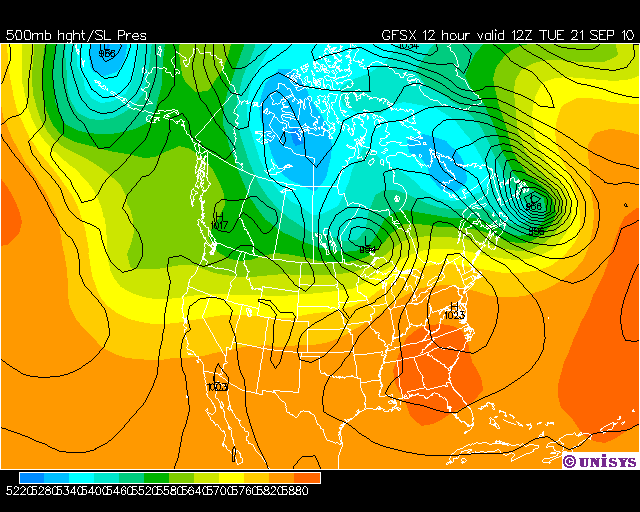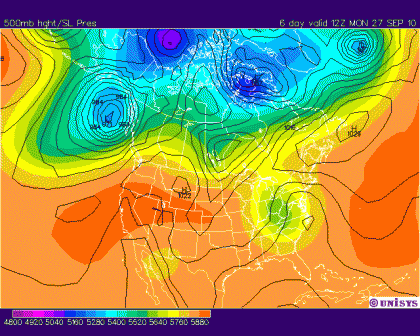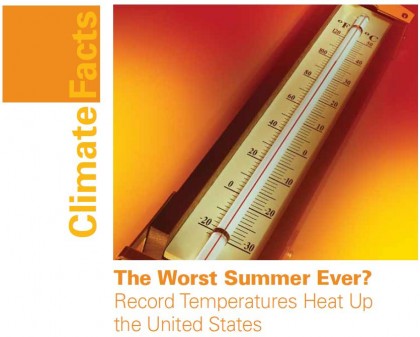21 September 2010
Is The Summer Heat Wave About To End At Last?
Posted by Dan Satterfield

Pressure pattern at around 18,000 feet (in colour bands) and at the surface (in black lines) for today. The the big high pressure ridge over the East is clearly visible.
For those of you in the Midwestern and Southern parts of America you are likely wondering what the heck happened to fall! Temperatures here in Huntsville in Alabama are running 15 degrees above normal in the afternoon!
This heat wave actually stretches from Oklahoma all the way into Illinois, into Virginia and deep into Old Dixie. It’s really the same heat wave that existed June through August and brought many cities the hottest summer on record.
Same Old Heat Wave
The only difference now is that the days are over an hour shorter and the sun is not as high in the sky. So instead of 106° we see 96°F. Instead of a dew point of 77° we are getting some drier air lingering behind the very weak cool fronts that have managed to break through the upper level ridge. The dew point her ein Huntsville now is 59°F.

By early next week the pattern changes dramatically with a trough in the east. This means much cooler air and even some desperately needed rain. (Courtesy Unisys weather ECM Model.)
Good news is coming.
The long range numerical weather models are all signaling a pattern change to cooler weather starting this weekend. The strong upper level (heat) ridge will shift to the West and allow the Pacific NW to dry out and see some sun. The East will finally feel some real fall weather.
Right On cue
Meteorological Autumn began back on September first, but most people still use the equinox to denote fall. That occurs at 3:09 GMT Thursday morning. That’s 10:09 PM Wednesday evening (Central U.S. summer time.)
The NRDC has compiled some incredible statistics of the summer heat that are worth taking a look at. You cannot blame any one event or even a brutally hot summer on climate change, but this past summer had some very suspicious patterns to the heat. Patterns that are exactly what you would expect as a result of increasing greenhouse gases.
You can certainly rule out the sun. It has been unusually quiet (see the previous post). You can also rule out El Nino, since the La Nina has been rapidly developing and this acts to cool the planet.



 Dan Satterfield has worked as an on air meteorologist for 32 years in Oklahoma, Florida and Alabama. Forecasting weather is Dan's job, but all of Earth Science is his passion. This journal is where Dan writes about things he has too little time for on air. Dan blogs about peer-reviewed Earth science for Junior High level audiences and up.
Dan Satterfield has worked as an on air meteorologist for 32 years in Oklahoma, Florida and Alabama. Forecasting weather is Dan's job, but all of Earth Science is his passion. This journal is where Dan writes about things he has too little time for on air. Dan blogs about peer-reviewed Earth science for Junior High level audiences and up.